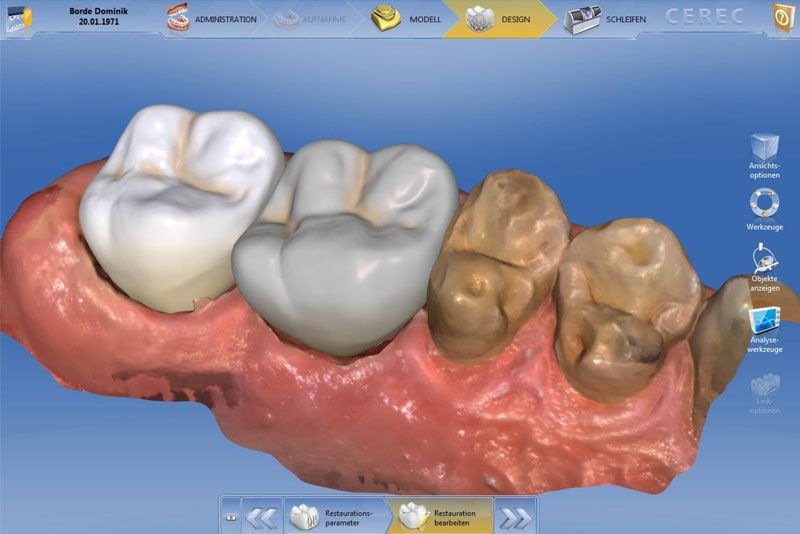
How about an all-ceramics bridge that you don’t have to wait for? That can be inserted right after preparing the abutment teeth, in one setting with no extra appointments? CEREC (Chairside ceramic reconstruction) can grant this wish: With our CEREC system, we are able to produce up to 4-unit bridges (i.e., replacements for two missing teeth) for the posterior region right here in the office.
Longer bridges have to be lab-made in any case, as they need a metal frame for additional stability. Why do we recommend CEREC bridges only for the posterior region? Well – if you insist on it, we might grind you a CEREC bridge replacing missing incisors or canines. Such a bridge would be an acceptable solution – but it wouldn’t meet our standard of always offering you optimum service with regard to cost as well as quality. Laboratory-manufatured dental reconstructions are glazed by hand with multiple wafer-thin ceramic layers to resemble the natural translucence properties of teeth most closely.
You can get further Informations about the costs of veneers in our download section(german only) or directly in our Practice in 1010 Vienna.
For the highly visible anterior region those lab-made bridges still offer better quality than CEREC. And just as well – if you insist on it, we might sell you a short bridge for the posterior region that has been manufactured in the lab. However, we would advise against it as we believe you would be subjected to unnecessary extra costs without any tangible advantage.
But back to the topic of instant bridge solutions: How do we make a bridge in the chairside procedure?
First, we prepare the abutment teeth left and right from the gap that will be supporting the bridge. We bring them into a slightly tapered form, with a little margin right above the gum line. After finishing the preparation and as soon as any bleeding of the gums has stopped, we will create an optical imprint of the situation around the missing tooth or teeth with our intraoral camera. We scan the prepared abutment teeth and also the teeth in the opposing arch. From the scan data, the computer calculates a threedimensional model and a draft for the new bridge. This draft can then be modified and optimized at the monitor by the dentist. Fine tuning the design of the occlusal surfaces to ensure that both dental archs fit well together requires some experience.


The next step is the actual fabrication of the new bridge from a block of ceramics by a computer controlled milling machine. After a glaze firing and a manual polish, the bridge is then ready to be inserted. The adhesive luting (fixation) of the bridge with a light-cured composite resin takes a little work, too: To increase the durability of the connetion between tooth and crown the bond must be formed under absolutely dry conditions.
For this purpose, we work on top of a rubber membrane (the Cofferdam) that is stretched above your gums. After the bridge has been integrated, we will send you on your way with a final polish and a little touch-up with fluoride enamel. A CEREC bridge appointment can last as little as two hours from beginning (abutment preparation) to end (finished teeth). An almost breathtaking improvement, compared to the traditional bridge procedure that requires at least two appointments about a week or longer apart and the insertion of a temporal bridge.
However, strong bleeding of the gums after the abutment teeth preparation may upset this time plan a little. Before we can put the intraoral camera to work, all bleeding must have stopped completely. Otherwise, the optical scan will not reach the necessary precision.
In cases of continuous bleeding, we will provide you with a quick provisional solution and give you an appointment for the following day. Starting with the optical imprint, we will then continue the treatment as described above.

